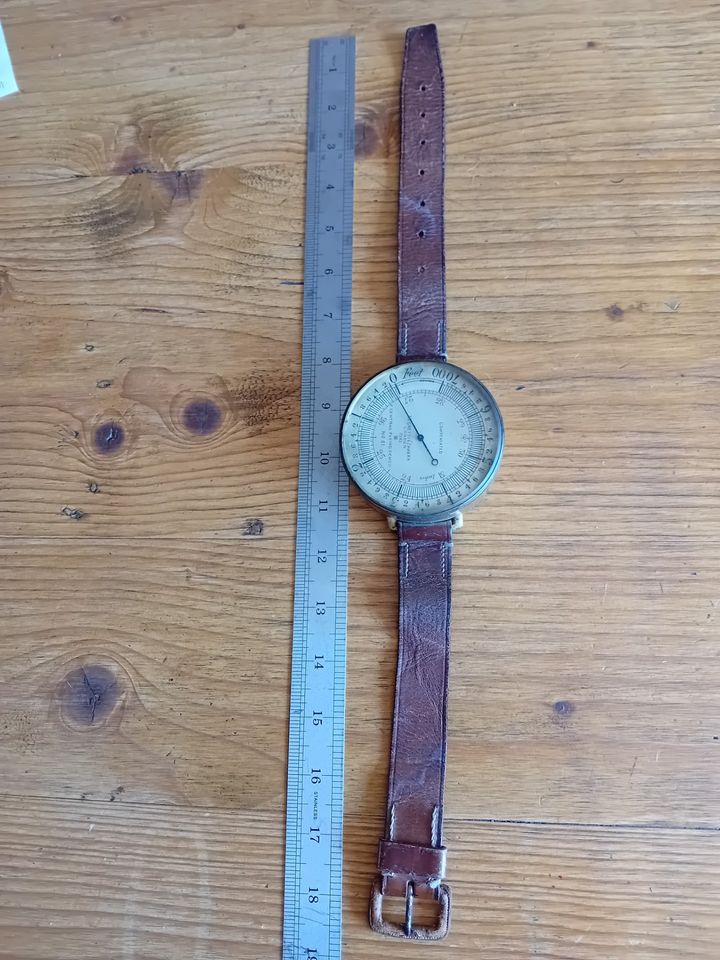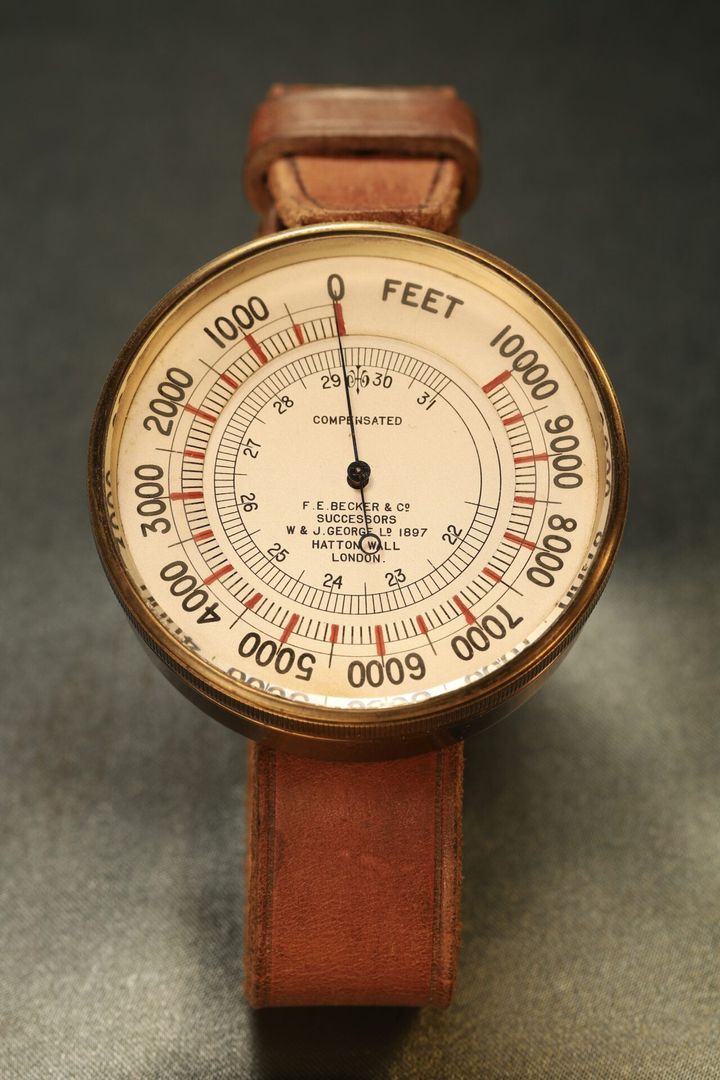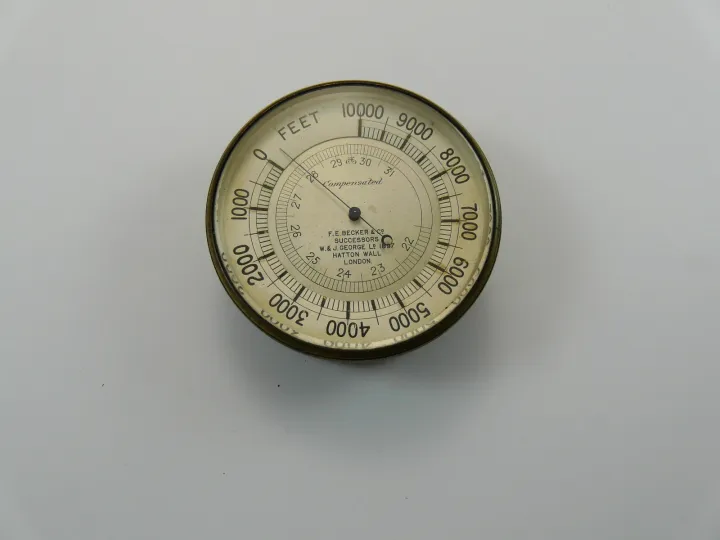Interesting Aviation Inheritance......
Discussion
What do you make of this?


I believe it is a wrist altimeter. Manufactured by a noted instrument (barometers etc) manufacturer Negretti & Zambra for the Central Flying School.
It is 3" in diameter and the total strap length is 15", giving a total length of 18". Presumably, it was intended to be worn OVER the wearer's flying gloves.
I was told that it would probably have been worn by a flying instructor - I imagine that occupation was pretty risky: the danger of an inexperienced pilot flying straight into the side of a mountain would (perhaps) convince the instructor to get some insurance - perhaps in the shape of an independent altimeter? They would typically cost around £900 in today's money.
A quick Google shows that the Central Flying School was formed in 1912. In 1919 it was redesignated the Flying Instructors School RAF. (According to the font of all knowledge that is Wikipedia).
So, presumably it was manufactured between 1912 & 1919.
Note the maximum altitude is 7000 feet, pretty high back then - the first pilot to fly at over 1 mile high was Walter Brookins' (6175 feet) in 1910.
Anyway. Just a bit of aviation interest. I'd be interested in any more information.

I believe it is a wrist altimeter. Manufactured by a noted instrument (barometers etc) manufacturer Negretti & Zambra for the Central Flying School.
It is 3" in diameter and the total strap length is 15", giving a total length of 18". Presumably, it was intended to be worn OVER the wearer's flying gloves.
I was told that it would probably have been worn by a flying instructor - I imagine that occupation was pretty risky: the danger of an inexperienced pilot flying straight into the side of a mountain would (perhaps) convince the instructor to get some insurance - perhaps in the shape of an independent altimeter? They would typically cost around £900 in today's money.
A quick Google shows that the Central Flying School was formed in 1912. In 1919 it was redesignated the Flying Instructors School RAF. (According to the font of all knowledge that is Wikipedia).
So, presumably it was manufactured between 1912 & 1919.
Note the maximum altitude is 7000 feet, pretty high back then - the first pilot to fly at over 1 mile high was Walter Brookins' (6175 feet) in 1910.
Anyway. Just a bit of aviation interest. I'd be interested in any more information.
Edited by alfaspecial on Wednesday 30th April 20:08
Bit more information. Note there is a scale of inches (ie equiv. millibars) as well as feet. So it's possibly a combination of an altimeter and a aneroid barometer.
The bezel turns so that the instrument can be set against known altitude / air pressure?
The bezel turns so that the instrument can be set against known altitude / air pressure?
Edited by alfaspecial on Wednesday 30th April 20:25
Simpo Two said:
For some reason I recognised the name ' Negretti & Zambra' but couldn't have told you why until I saw the photos.
Wouldn't an instructor always have sight of a 'proper' altimeter though? Maybe this is for mountain climbers...
Wouldn't an instructor always have sight of a 'proper' altimeter though? Maybe this is for mountain climbers...

Specifically, mountain climbers attending the Central Flying School.

Yertis said:
Simpo Two said:
For some reason I recognised the name ' Negretti & Zambra' but couldn't have told you why until I saw the photos.
Wouldn't an instructor always have sight of a 'proper' altimeter though? Maybe this is for mountain climbers...
Wouldn't an instructor always have sight of a 'proper' altimeter though? Maybe this is for mountain climbers...

Specifically, mountain climbers attending the Central Flying School.

In fact, in the period in question when the CFS was operating, they may well have been flying in something even more basic like a Farman Longhorn or a Bristol Boxkite, which didn't even have a recognisable cockpit, let alone any instruments to mount in it
Edited by 2xChevrons on Thursday 1st May 14:02
Yertis said:
Who needs ChatGPT when we have 2xChevrons. 
Is there no limit to your wisdom?
You flatter me (although not with the comparison to the plagiarising lie machine that is ChatGPT - it would be lovely if we really could do without it. No discussion is improved by the heart-sinking phrase "Well I asked ChatGPT and...").
Is there no limit to your wisdom?
But my 'wisdom' (trivia ain't wisdom) definitely has limits! Notice that I don't post on any of the forums to do with watches, business, electronics, travel, DIY, books, TV, the automotive engineering one or any of the marque-specific ones.
If it's not about old cars, old trains, old boats or old planes then I'm mostly out of ideas. It just so happens that my store of useless facts coincides with a lot of PH content.
I can't find another with a wristwatch-style strap, but the same main bit comes up in searches, like this one from 1900: https://www.sellingantiqueslite.co.uk/1125157/anti...
As that's pre-aeroplane perhaps it was originally used by balloonists as well as mountain climbers.
As that's pre-aeroplane perhaps it was originally used by balloonists as well as mountain climbers.
Not quite the same though is it, not having ‘Central Flying School’ on the face. The Central Flying School was founded in 1912, I guess by the RFC.
Edited to add that I now realise Simp was talking about the one he found, not the OP's example
Edited to add that I now realise Simp was talking about the one he found, not the OP's example

Edited by Yertis on Thursday 1st May 20:26
Thanks for your thoughts, folks.
This is a similar item
https://vavasseur-antiques.com/portfolio/wwi-wrist...

or this one 'sold' Ebay https://www.ebay.co.uk/itm/177014489136

This is a similar item
https://vavasseur-antiques.com/portfolio/wwi-wrist...
or this one 'sold' Ebay https://www.ebay.co.uk/itm/177014489136
Yertis said:
Not quite the same though is it, not having ‘Central Flying School’ on the face. The Central Flying School was founded in 1912, I guess by the RFC.
Looks like the CFS simply got the makers to put their name on a certain number of them.If the technology to measure pressure/altitude in a small box existed in 1900, why would aircraft makers not put altimeters in their aircraft?
Simpo Two said:
Yertis said:
Not quite the same though is it, not having ‘Central Flying School’ on the face. The Central Flying School was founded in 1912, I guess by the RFC.
Looks like the CFS simply got the makers to put their name on a certain number of them.If the technology to measure pressure/altitude in a small box existed in 1900, why would aircraft makers not put altimeters in their aircraft?
Gassing Station | Boats, Planes & Trains | Top of Page | What's New | My Stuff



